![]()
![]()
![]()
Use LEFT and RIGHT arrow keys to navigate between flashcards;
Use UP and DOWN arrow keys to flip the card;
H to show hint;
A reads text to speech;
52 Cards in this Set
- Front
- Back
|
Dispersion is a _______ concept. What are the three types of dispersion and which is the most common? |
Dispersion is a statistical concept. The three types of dispersion are hyperdispersion, random dispersion, and aggregated/clumped dispersion (most common). |
|
|
Define equidistant in terms of hyperdispersion |
Equidistant is the term in hyperdispersion where individuals are distributed without respect to others. |
|
|
Provide examples of hyperdispersion? |
Examples of hyperdispersion include fish schools and seabirds. |
|
|
Give an example of random dispersion. |
Examples of random dispersion include grazing wildebeest, beach clams, forest spiders. |
|
|
What are the two types of clumped dispersion? |
The two types of clumped dispersion are coarse grained and fine grained. |
|
|
What is the difference between course grained and fine grained dispersion? |
Coarse grained dispersion is when clumps are separated by large areas, whereas fine grained is when clumps are separated by short distances. |
|
|
What are the major reason for clumped distribution in plants? |
The major reason for clumped distribution in plants is because of the local differences in microhabitat. |
|
|
What are the two major reasons for clumped distributions in animals? |
The two major reasons for clumped distribution in plants are 1) resources are clumped and 2) behaviours that facilitate grouping. |
|
|
Define dispersal. |
Dispersal is the movement done by individual organisms in which they leave the initial environment which they were born in. |
|
|
What does dispersal lead to? |
Dispersal leads to gene flow. |
|
|
Define migration. |
Migration is the directional movement of a large group of individuals from one area to the next. |
|
|
Define density. |
Density is the number of individuals per unit area/volume. |
|
|
What are three ways to estimate population density? |
The three ways to estimate population density are: 1) Total count (photography) 2) Quadrat sampling 3) Mark, release, and recapture estimates |
|
|
What are the steps in the Peterson/Lincoln Index Mark Release Recapture? |
With the Peterson/Lincoln Mark and Recapture Method, a random group of individuals in a population are captured, marked, and released back into the environment. After a period of time, a random group of individuals is again captured, and the ratio of marked:unmarked individuals are recorded. |
|
|
What is the population size equation for Peterson/Lincoln? |
The population size equation for Peterson/Lincoln method is: M/N = m/n |
|
|
Which variation of the Peterson/Lincoln method extends to open populations? |
The Jolly-Seber Method is a variation of the Peterson/Lincoln method and extends to open populations. |
|
|
Which variation of the Peterson/Lincoln method does more than one recapture sampling? |
The Schnabel Method is an extension of the Peterson/Lincoln method in which the recapturing portion is done more than once. |
|
|
What are the four assumptions in mark-recapture studies for reliable population estimates? |
1) The population stays constant during the study. 2) It is equally likely to catch marked or unmarked individuals. 3) Capturing/marking does not increase mortality rates in the marked individuals. 4) Individuals do not lose their marks. |
|
|
What is the equation for predicting total population size over time? |
The equation for predicting total population size over time is: Nt+1 = Nt + B + I - D - E |
|
|
Define fertility. |
Fertility is a female's ability to produce offspring per a period of time. |
|
|
What are the four characteristics that life tables are useful for estimating? |
1) Mortality rates 2) Survival rates 3) Survivorship curves 4) Average life expectancy |
|
|
What are the two types of life tables? |
The two types of life tables are age specific and time specific. |
|
|
Explain age-specific (cohort) analysis. What is it most useful on? |
Age-Specific analysis follows a specific group of individuals from birth to death. It is most useful on short-lived species like mice and songbirds. |
|
|
Explain time-specific analysis. Which species are it used for? |
Time-specific life tables look at the age structure of a population during a single point in time in which age distribution is required. It is used for most large animals. |
|
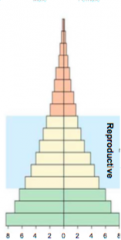
What is this graph indicative of? |
This graph shows potential rapid population growth. |
|
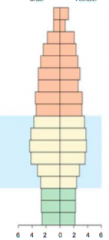
What is this graph indicative of? |
This graph shows a stable or decreasing population. |
|
|
What are epigenetic profiles? |
Epigenetic profiles are the extent of methylation on genes associated with aging. |
|
|
What is the equation for survivorship? |
The equation for survivorship is: lx = Ntx / Nt |
|
|
What is the equation for mortality? |
The equation for mortality is: qtx = (Ntx - Ntx+1) / Ntx |
|
|
Define life expectancy. |
Life expectancy is the expected number of years left in a population at any specific age. |
|
|
In the actual survivorship curve graph, which species are which graph type? |
Type 1: Many mammals Type 2: Many birds, small mammals, lizards, turtles Type 3: Many invertebrates, fish, amphibians, plants |
|
|
Define Age-Specific Fecundity Rate (ASFR). |
Age-specific fecundity rate is the average number of male and female offspring produced per female for each age group. |
|
|
Define total fecundity rate. |
Total Fecundity Rate is the average number of male and female offspring produced per female over her lifetime. |
|
|
Define Net Reproductive Rate (NRR), aka R0. |
The Net Reproductive Rate (NRR), shown by R0, is the average number of breeding daughters that will be produced by each breeding female in the population in her lifetime. |
|
|
What is the equation for a semelparous population size? |
Semelparous population size equation is: Nt+1 = RoNt |
|
|
Define geometric growth. |
Geometric Growth is the event in which the population grows without constraints. |
|
|
What is the equation for an iteroparous species' population growth? |
The equation for an iteroparous species' population growth is: dN / dt = rN |
|
|
What is the equation for r (per capita rate of population growth and what do its values mean? |
The equation for r is: r = birth rate (b) - death rate (d) When r is negative, population declines; when it is 0, it is stable; when it is positive, population increases. |
|
|
What is the equation for geometric growth with overlapping generations? |
The equation for geometric growth with overlapping generations is: Nt = N0e^rt |
|
|
What is carrying capacity (K)? |
Carrying Capacity (K) is the total number of individual of a species that can be sustained in a habitat in the long term. |
|
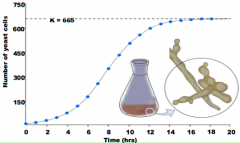
Which logistic growth variation is this graph an example of? |
This graph is an example of ideal logistic, or smooth response, variation. |
|
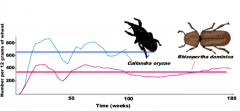
Which logistic growth variation is this graph an example of? |
This graph is an example of damped oscillation variation. |
|
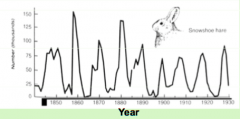
Which logistic growth variation is this graph an example of? |
This graph is an example of a stable limit cycle variation. |
|

Which logistic growth variation is this graph an example of? |
This graph is an example of chaotic variation. |
|
|
What is the carrying capacity of a habitat influenced by? |
The carrying capacity of a habitat is influenced by "the most limiting resource". |
|
|
What are the two types of factors limiting population growth? |
The two types of factors limiting population growth are density-dependent population regulation and density-independent population regulation. |
|
|
What are density-dependent population regulations due to? |
Density-dependent population regulations are due to intrinsic factors. |
|
|
What are the six mechanisms for density-dependent effects when populations exceed K? |
1) Intraspecific competition 2) Delayed breeding or reduced offspring production 3) Increased territoriality 4) Dispersal 5) Parasites/Disease 6) Predators |
|
|
Define interference competition. Give an example. |
Interference competition is the event where individuals directly interfere with others for limited resources. E.g. Gulls stealing from others, lions excluding others from a kill, etc. |
|
|
Give some general mechanisms for birth rate reduction and population regulations at high population densities. |
General mechanisms: 1) Increased agonistic encounters 2) Increased stress in sub-dominant animals 3) Stress triggers altered growth and sex hormone secretion 4) Causes suppression of body growth, reproduction, and immune system 5) Causes enlarged adrenal glands, inflamed kidneys, uterine mortality and reduced lactation (pregnant individuals) 6) Young born to stressed moms have low body weight, poor survival, delayed puberty, and low reproductive rate 7) Female urine's odour |
|
|
What are density-independent population regulations due to? |
Density-independent population regulations are due to extrinsic factors. |
|
|
What are sunspots? When do sunspots occur? |
Sunspots are localized zones of reduced heat output. They occur when a concentrated portion of the suns' magnetic field pokes through the surface. |

